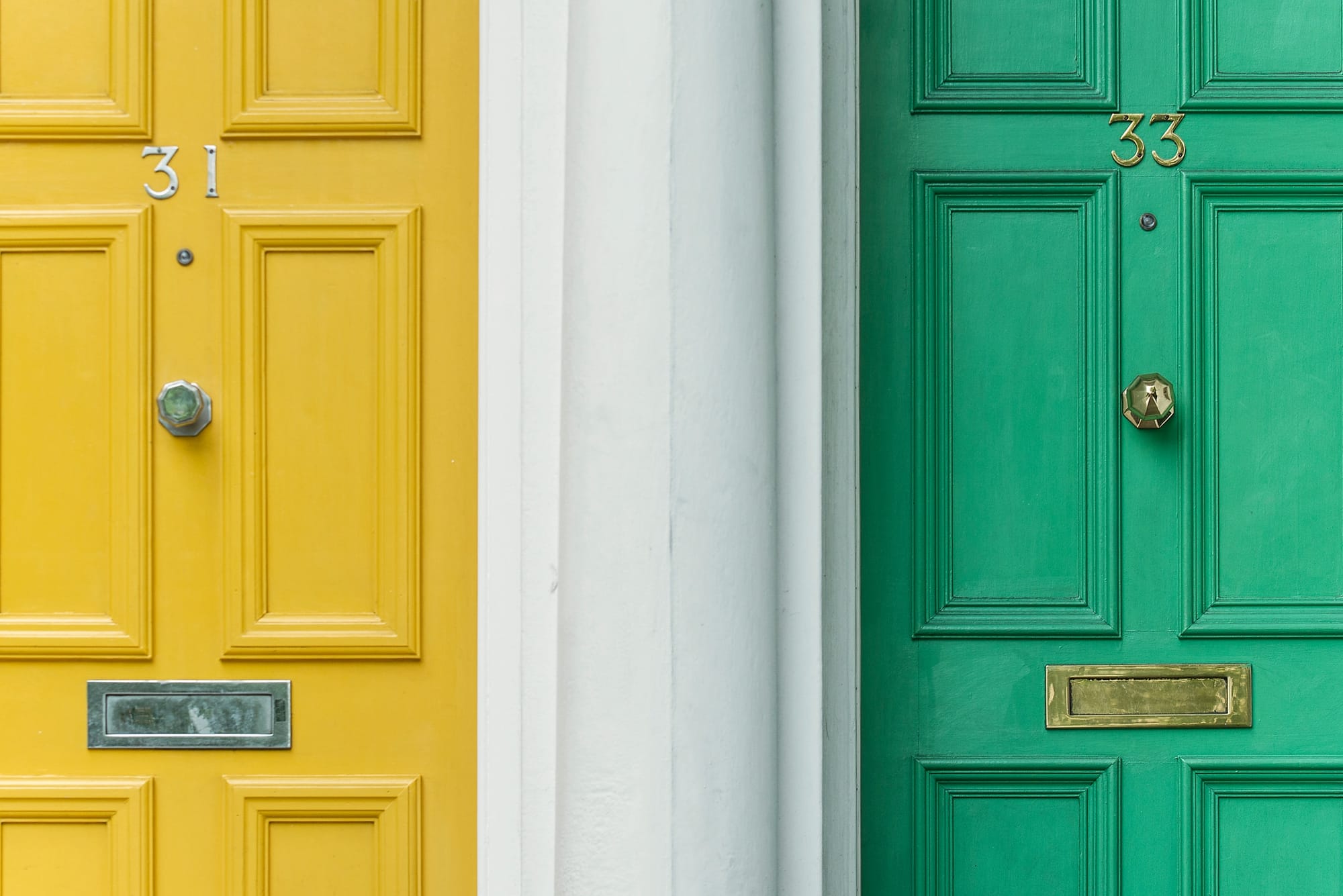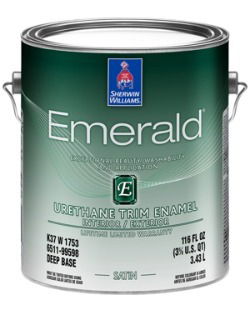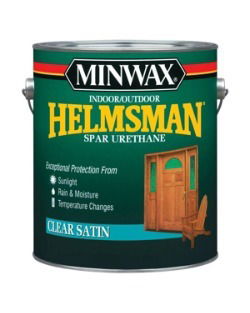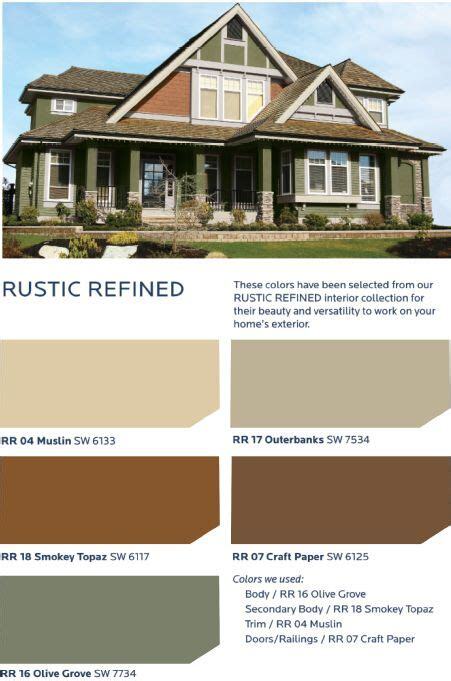10 Front Door Colors That Perfectly Complement Tan Siding

Key Features:
- High-Build Formula for Superior Coverage - Effective Crack Bridging: The high-build technology in Regal® Select Exterior High Build allows the paint to effectively bridge small cracks and voids. This results in a smooth and uniform surface with fewer coats, providing a professional-grade finish that enhances both protection and appearance.
- Durability and Weather Resistance - Enhanced Durability: The 100% acrylic composition enhances durability, making the paint highly resistant to harsh weather conditions, UV rays, and moisture. This ensures that the exterior surfaces maintain their appearance and protective qualities for an extended period, even in challenging climates.
- Versatile Application and Mildew Resistance - Sag-Resistant Formula: Regal® Select Exterior High Build offers a sag-resistant formula that facilitates seamless application on various substrates, including wood, vinyl/PVC, masonry, and fiber cement board. Additionally, its mildew-resistant properties help keep surfaces clean and free from mold, enhancing the longevity and aesthetic appeal of the paint job.
The Impact of Front Door Color on Curb Appeal
Enhancing Visual Appeal
First Impressions Matter
The front door is often the first thing people notice about your home, making it a crucial element in creating a positive first impression. As the focal point of the home’s exterior, the front door color can significantly influence the overall aesthetic and appeal. A well-chosen front door color can set the tone for your home’s style, whether it’s modern, traditional, or eclectic.
Imagine walking up to a house with a bold red door versus one with a faded, bland entryway. The vibrant red door immediately captures attention and adds a sense of warmth and welcome, showcasing the homeowner's personality and enhancing the home's visual appeal.
Boosting Property Value
The color of your front door doesn’t just impact how your home looks—it can also affect its market value. A well-selected exterior color scheme, including the front door, can increase a property's curb appeal, making it more attractive to potential buyers. Studies have shown that homes with appealing exterior colors sell faster and at higher prices compared to those with less inviting color schemes.
For instance, Zillow conducted a study that found homes with front doors painted in shades of black or charcoal grey sold for up to $6,000 more than expected. This statistic underscores the financial benefit of investing in a striking front door color, making it a small change with potentially significant returns.
In Our Experience:
"We've seen firsthand how a well-selected front door color can transform a home's appearance. I recall a project in Portland where we transformed a home by changing its front door to a deep blue, creating a stunning focal point that tied the exterior together beautifully. Our commitment to quality and attention to detail ensures that each project exceeds expectations. Whether opting for a bold hue or a subtle shade, the right front door color can reflect your style, complement your home's architecture, and even boost its market value."
10 Front Door Colors That Perfectly Complement Tan Siding
Classic and Timeless Choices
1. Navy Blue
- Why it works: The classic, bold contrast with tan siding creates a striking look.
- Best settings: Traditional and modern homes.
2. Forest Green
- Why it works: Natural, earthy tones harmonize beautifully with tan, creating a cohesive look.
- Best settings: Rustic and farmhouse styles.
3. Burgundy
- Why it works: Rich and inviting, this color adds depth and sophistication to your exterior.
- Best settings: Classic and colonial homes.
Bright and Bold Options
4. Bright Red
- Why it works: Eye-catching and vibrant, adding a pop of color that stands out.
- Best settings: Contemporary and eclectic homes.
5. Turquoise
- Why it works: Fresh and lively, perfect for coastal and cottage styles, bringing a playful vibe.
- Best settings: Beach houses and playful designs.
6. Sunshine Yellow
- Why it works: Cheerful and welcoming, this color makes a bold statement.
- Best settings: Traditional and modern homes.
Neutral and Subtle Shades
7. Charcoal Grey
- Why it works: Sleek and sophisticated, a modern neutral that complements tan siding beautifully.
- Best settings: Urban and minimalist designs.
8. Black
- Why it works: Timeless elegance that makes a strong, classic statement.
- Best settings: Classic and contemporary homes.
9. Warm Brown
- Why it works: Earthy and cozy, blending well with natural surroundings for a warm aesthetic.
- Best settings: Rustic and traditional homes.
Unique and Trendy Choices
10. Olive Green
- Why it works: Unique yet subtle, adding character and charm to your exterior.
- Best settings: Mediterranean and eclectic styles.

Tips for Choosing the Perfect Front Door Color
Consider Your Home’s Style and Setting
Architectural Harmony
Choosing a front door color that complements your home’s architectural style is crucial for achieving a cohesive and appealing look. Here are some tips for ensuring architectural harmony:
- Traditional Homes: Colors like navy blue, burgundy, and forest green often work well with traditional architecture. These colors provide a classic look that enhances the elegance of traditional designs.
- Modern Homes: For modern and minimalist homes, sleek colors like charcoal grey, black, and bold shades like bright red can create a striking contrast that highlights the clean lines and contemporary aesthetics.
- Rustic and Farmhouse Styles: Earthy tones such as warm brown and forest green blend seamlessly with the natural elements commonly found in rustic and farmhouse designs.
- Coastal and Cottage Styles: Light and vibrant colors like turquoise and sunshine yellow add a playful, welcoming touch to coastal and cottage homes.
Examples of Successful Color Matches
- Victorian Homes: Deep, rich colors like burgundy or navy blue can accentuate the intricate details of Victorian architecture.
- Mediterranean Homes: Warm, earthy tones like olive green or terracotta can enhance the stucco exteriors and natural landscapes of Mediterranean-style homes.
- Colonial Homes: Classic shades like black or dark green can provide a stately, timeless look that complements the symmetrical and formal appearance of colonial homes.
Practical Considerations
Climate and Environment
Your local climate and surroundings play a significant role in choosing the right front door color. Here are some practical considerations to keep in mind:
- Sunlight Exposure: In regions with intense sunlight, lighter colors like white or pastel shades can reflect heat and prevent the door from warping or fading. Conversely, in cooler climates, darker colors can absorb heat and add a cozy warmth to your home’s entrance.
- Weather Conditions: If you live in an area prone to harsh weather conditions like rain, snow, or high humidity, it’s essential to choose weather-resistant paints and finishes. High-quality, durable paints designed for exterior use can withstand the elements and maintain their appearance longer.
- Natural Surroundings: Consider the natural landscape around your home. A front door color that blends harmoniously with your surroundings can enhance the overall curb appeal. For instance, earthy tones may complement a wooded area, while bright, vibrant colors may stand out beautifully in a more urban setting.
Recommendations for Weather-Resistant Paints and Finishes
- Durability: Look for exterior paints that offer UV protection, mildew resistance, and are specifically formulated to withstand extreme weather conditions.
- Finishes: Opt for finishes that are easy to clean and maintain. Semi-gloss and high-gloss finishes are typically more resistant to dirt and easier to wipe clean than flat finishes.
- Brands: Consider reputable brands known for their quality and durability, such as Sherwin-Williams, Benjamin Moore, and Behr. These brands offer a wide range of colors and finishes designed to endure the outdoor elements.

How to Paint Your Front Door
Preparation and Materials
Gathering Supplies
Before you start painting your front door, it's essential to gather all the necessary tools and materials. Having everything on hand will make the process smoother and more efficient.
- Essential Tools and Materials:
- High-quality exterior paint (preferably weather-resistant)
- Primer (if the door has not been previously painted or is in poor condition)
- Paintbrushes (angled for detail work)
- Paint rollers (small to medium size)
- Painter’s tape
- Drop cloths
- Sandpaper (various grits)
- Clean rags or tack cloth
- Screwdrivers (to remove hardware)
- Paint tray
- Stir sticks
- Recommended Brands and Products:
- Paint: Sherwin-Williams Duration, Benjamin Moore Aura, Behr Marquee
- Primer: Zinsser Bulls Eye 1-2-3, KILZ Premium
- Tools: Purdy paintbrushes, Wooster rollers
Surface Preparation
Proper surface preparation is crucial for achieving a smooth and durable finish. Follow these steps to prepare your door for painting:
- Remove Hardware: Use a screwdriver to remove all door hardware, including handles, locks, and hinges if possible. This will make painting easier and result in a cleaner finish.
- Clean the Surface: Clean the door thoroughly with a mild detergent and water to remove dirt, grease, and grime. Rinse and let it dry completely.
- Sand the Door: Sand the entire surface of the door using fine-grit sandpaper (120-220 grit). This will help the paint adhere better and smooth out any imperfections. Wipe away the dust with a tack cloth.
- Apply Primer: If the door is bare wood, metal, or previously painted with a glossy finish, apply a coat of primer. Allow it to dry according to the manufacturer’s instructions.
Painting Techniques
Application Methods
To achieve a professional-looking finish, follow these painting techniques:
- Use Painter’s Tape: Apply painter’s tape around the edges of the door, windows, and any other areas you don’t want to paint. This will help create clean lines.
- Start with Panels: If your door has panels, start by painting the recessed areas and panels first. Use an angled brush for precision. Then, move to the flat areas and edges.
- Roll and Brush: Use a small roller for larger flat areas and a brush for detailed work. Apply the paint in thin, even coats, working in the direction of the grain (if wood) or from top to bottom.
- Avoid Overworking: Don’t overwork the paint. Apply it smoothly and avoid going over areas that are starting to dry, as this can cause streaks and uneven texture.
Drying and Finishing Touches
Proper drying times and finishing touches are key to a durable and attractive finish:
- Allow Adequate Drying Time: Let each coat of paint dry thoroughly before applying the next. Check the paint can for recommended drying times. Typically, it’s best to wait at least 24 hours between coats.
- Apply Additional Coats: Apply a second or third coat if necessary for full coverage and depth of color. Each layer should be thin and even.
- Reattach Hardware: Once the paint is completely dry, reattach the door hardware. Consider updating your hardware for a fresh new look that complements your new door color.
- Add Accessories: Enhance the look of your front door with accessories like a stylish door knocker, house numbers, or a decorative wreath.

Professional Help: When to Call in the Experts
Benefits of Hiring Professional Painters
Expertise and Experience
One of the primary benefits of hiring professional painters is their expertise and experience. Professional painters, like those at Lightmen Painting, have honed their skills over years of practice. They know the best techniques to ensure a smooth and even finish, the right types of paint to use for different surfaces, and how to avoid common painting pitfalls.
- Advantages of Using Professional Painting Services: Professional painters can handle any unexpected challenges that arise during a project. They have the knowledge to deal with various surfaces, weather conditions, and paint types to ensure the best results. They also provide a level of precision and detail that can be hard to achieve with a DIY approach.
- Success Stories from Satisfied Clients of Lightmen Painting: Our clients have shared numerous success stories highlighting the transformative power of a professional paint job. For instance, one client praised our team's ability to completely revitalize the exterior of their home, increasing its curb appeal and market value significantly. Another client appreciated our attention to detail and the clean, efficient manner in which we completed their front door painting project.
Saving Time and Effort
Hiring professional painters not only ensures high-quality results but also saves you time and effort. Painting, especially exterior painting, can be a time-consuming task that requires meticulous preparation and execution.
- Efficient Job Completion: Professional painters can complete the job more efficiently than the average homeowner, thanks to their experience and the right tools for the job. They can also handle all the preparatory work, like cleaning, sanding, and priming, which are crucial for a long-lasting finish.
- Testimonials and Case Studies: Clients who have hired Lightmen Painting often highlight how we helped them save time and effort. One homeowner shared how our team managed to paint their entire home exterior, including the front door, within a tight deadline, delivering impeccable results. Another case study involved a busy professional who could rely on our team to handle the painting project from start to finish, allowing them to focus on their work without interruption.
Choosing the right front door color can significantly enhance your home’s curb appeal, especially when complemented with tan siding. Don’t be afraid to experiment with colors to find the perfect match that reflects your personality and style. Whether you decide to tackle the project yourself or hire professionals, a fresh coat of paint can make a substantial difference.
Action
If you’re ready to transform your home’s exterior with a fresh, vibrant front door color, consider contacting Lightmen Painting. Our expert team is here to provide professional advice and high-quality painting services tailored to your needs. Share your front door transformations with us in the comments or tag us on social media. Let’s work together to enhance your home’s curb appeal and make a lasting impression!
-
People Also Ask:
What makes Regal® Select Exterior High Build different from other exterior paints?
Regal® Select Exterior High Build stands out due to its advanced high-build technology and 100% acrylic formulation. This unique combination allows the paint to bridge small cracks and voids effectively, providing a smooth and uniform surface with fewer coats. Its thick, high-build formula ensures minor imperfections are covered, resulting in a professional-grade finish. Additionally, its durability against harsh weather conditions, UV rays, and moisture ensures long-lasting protection and appearance for exterior surfaces.
Can Regal® Select Exterior High Build be used on different types of exterior surfaces?
Yes, Regal® Select Exterior High Build is versatile and suitable for a wide range of exterior materials. It provides excellent adhesion and protection for wood, enhancing its natural beauty and longevity. The paint also adheres well to vinyl/PVC, offering a durable and vibrant finish. For masonry, it seals and protects surfaces from moisture infiltration, enhancing structural integrity. Additionally, it ensures a long-lasting finish on fiber cement board, maintaining its aesthetic appeal and durability against the elements.
What are the benefits of the different finishes offered by Regal® Select Exterior High Build?
Regal® Select Exterior High Build offers three finishes: Flat (400), Low Lustre (401), and Soft Gloss (403), each providing unique benefits:
Flat Finish (400): Ideal for achieving a smooth, non-reflective appearance that hides imperfections effectively, perfect for large surface areas like siding and trim.
Low Lustre Finish (401): Delivers a lightly reflective sheen, enhancing the depth and character of the painted surface, suitable for areas exposed to moderate wear and tear.
Soft Gloss Finish (403): Provides a smooth, lustrous look that highlights architectural details and adds visual interest, perfect for doors, windows, shutters, and trim.
-
SUBSCRIBE TO OUR BLOG: Stay informed with the latest in Painting and DIY projects by subscribing to Lightmen Painting. Get insights, tips, and more delivered straight to your inbox. We would also love to know what you would like to read about, leave thoughts on where we should go next. Interests, Topics, Ideas, all are welcome.
If your in the Portland, Or. area and need advice or a free no obligation estimate call us at 503-389-5758 or email scheduling@lightmenpainting.com
Local Shout Out:
Celebrating Portland Spirit River Cruises: A Unique Perspective on Portland's Beauty
From the dedicated team at Lightmen Painting, we celebrate Portland Spirit River Cruises, offering unforgettable experiences and scenic views of Portland from the Willamette River. Just as we are committed to excellence in our painting services, Portland Spirit River Cruises provides top-tier service and memorable outings, whether for dining, sightseeing, or special events. These cruises offer a distinctive way to appreciate the natural beauty and urban landscape of Portland, much like how we aim to enhance and beautify spaces for our clients.
Thanks for stopping by Lightmen Daily! Stay tuned for more practical tips and expert advice on making your painting projects flawless, from wall to floor!
Definitions
- Curb Appeal: The attractiveness of a property and its surroundings when viewed from the street, which can influence the impression and market value.
- Focal Point: The visually dominant element in a space that draws attention, such as a front door in the exterior of a home.
- Architecture: The style and design of a building, including its structure and exterior appearance.
- Navy Blue: A classic, bold color that creates a striking contrast with tan siding, ideal for traditional and modern homes.
- Forest Green: A natural, earthy color that harmonizes with tan siding, suitable for rustic and farmhouse styles.
- Burgundy: A rich, inviting color that adds depth and sophistication, perfect for classic and colonial homes.
- Bright Red: An eye-catching and vibrant color that adds a pop of brightness, suited for contemporary and eclectic homes.
- Turquoise: A fresh and lively color, often used in coastal and cottage styles for a playful vibe.
- Sunshine Yellow: A cheerful and welcoming color that makes a bold statement, suitable for traditional and modern homes.
- Charcoal Grey: A sleek and sophisticated color that complements tan siding, ideal for urban and minimalist designs.
- Black: A timeless and elegant color that makes a strong, classic statement, fitting for classic and contemporary homes.
- Warm Brown: An earthy and cozy color that blends well with natural surroundings, ideal for rustic and traditional homes.
- Olive Green: A unique yet subtle color that adds character and charm, suitable for Mediterranean and eclectic styles.
- Architectural Harmony: The concept of choosing colors and designs that complement the architectural style of a home.
- Sunlight Exposure: The amount and intensity of sunlight that an exterior surface receives, which can affect paint color and durability.
- Weather Conditions: The typical environmental conditions in an area, such as rain, snow, and humidity, which influence the choice of exterior paint.
- Natural Surroundings: The landscape and environment around a home, which can impact color choices to create a harmonious look.
- Weather-Resistant Paints: Paints designed to withstand harsh weather conditions, including UV protection and mildew resistance.
- Surface Preparation: The process of cleaning, sanding, and priming a surface before painting to ensure better adhesion and a smooth finish.
- Primer: A preparatory coating applied to a surface before painting, enhancing paint adhesion and durability.
- Painter’s Tape: Adhesive tape used to mask off areas that should not be painted, ensuring clean lines and edges.
- Drop Cloths: Protective sheets used to cover and protect surfaces from paint spills and drips during a painting project.
- Sandpaper: Abrasive paper used for smoothing surfaces and removing old paint before applying a new coat.
- Cleaning Solution: A mixture used to clean surfaces before painting, removing dirt, grease, and grime.
- Paintbrushes and Rollers: Tools used for applying paint, with brushes for detail work and rollers for larger areas.
- Semi-Gloss and High-Gloss Finishes: Paint finishes that are more resistant to dirt and easier to clean, compared to flat finishes.
- Exterior Paint Brands: Reputable brands known for their quality and durability, such as Sherwin-Williams, Benjamin Moore, and Behr.
- Professional Painters: Skilled individuals or companies with expertise in painting, capable of delivering high-quality and precise finishes.
- Client Testimonials: Feedback and reviews from clients who have experienced the services of a painting company, highlighting their satisfaction and the results achieved.
- Weather-Resistant Finishes: Paint finishes specifically formulated to endure outdoor conditions, maintaining their appearance and protection over time.
Lightmen Painting Serving: Portland, Tigard, Lake Oswego, Tualatin, West Linn, Milwaukie, Sherwood, Happy Valley, Oregon City, Beaverton, Hillsboro, Gresham
